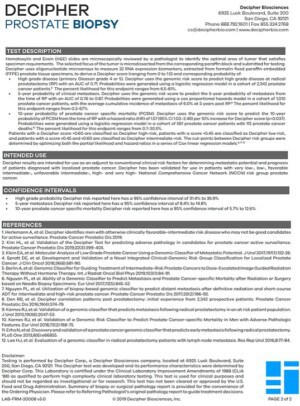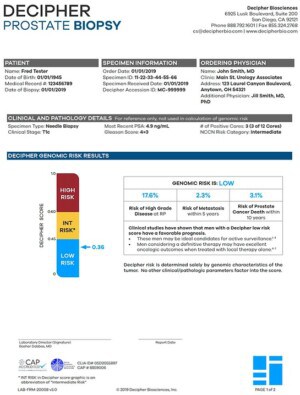What do my Decipher results mean?
Decipher Biopsy was designed to be used in patients who have been diagnosed with organ confined prostate cancer but are not quite sure if they need to seek definitive treatment or may undergo an active surveillance protocol with their health care provider.
The Decipher Biopsy test was designed for individuals with low, favorable intermediate, and unfavorable intermediate risk prostate cancer (less than or equal to Gleason 4+3=7) who are uncertain if they should get treatment or pursue active surveillance.
The test looks at the activation of 22 RNA biomarkers (using specialized lab tests using your prostate cancer positive tissue) associated with metastatic progression. These markers review your prostate cancer tissue and evaluate your cancers cell cycle progression, immune system activity and response, androgen signaling pathways, metabolism, and angiogenesis potential (cancer cell blood vessel formation).
Patient Sample Report
See below for an example and explanation of the Decipher Biopsy Test results.

Clinical Details:
This area describes clinical details associated with your prostate cancer. This information is gathered from your pathology report and is NOT used to generate your Decipher result
Decipher Score (meter):
This section describes the overall risk results of your Decipher test. Generally, the lower the Decipher Score (0 being lowest risk to 1 being highest risk), the lower the risk of high grade disease, metastatic spread, and prostate cancer specific mortality. This score, as well as your risk percent likelihood (described below), may help your health care provider determine if active surveillance may be appropriate, or if treatment intensification may be needed for a definitive therapy such as surgery or radiation therapy and/or hormone deprivation therapy to reduce the risk of metastases.
High Grade Disease
High grade cancer cells (with Primary Gleason 4 or 5 on surgical pathology) tend to grow and spread more quickly than low-grade cancer cells. High grade cancers often have worse prognosis than low-grade cancers and may need treatment right away or treatment that is more aggressive. In this example 12.3% likelihood means that if the patient underwent a radical prostatectomy, there would be a 12.3% risk or likelihood that the patient may receive a primary Gleason grade of 4 or 5 upon surgical pathology review. The higher the percentage, the greater the risk.
5-Year Metastasis
This represents your overall risk of having prostate cancer that may spread to other areas, most commonly bone. In this example 1% likelihood means that, if the patient underwent a radical prostatectomy, there would be a 1% chance the patient may develop metastasis within 5 years. The higher the percentage, the greater the risk.
10-Year Prostate Cancer Specific Mortality
This represents your overall risk of prostate cancer specific death after 10 years based on the genomic characteristics of your prostate cancer. In this example 1.9% likelihood means that, if the patient underwent a radical prostatectomy, there would be a 1.9% chance the patient may die from prostate cancer at 10 years. The higher the percentage, the greater the risk.

